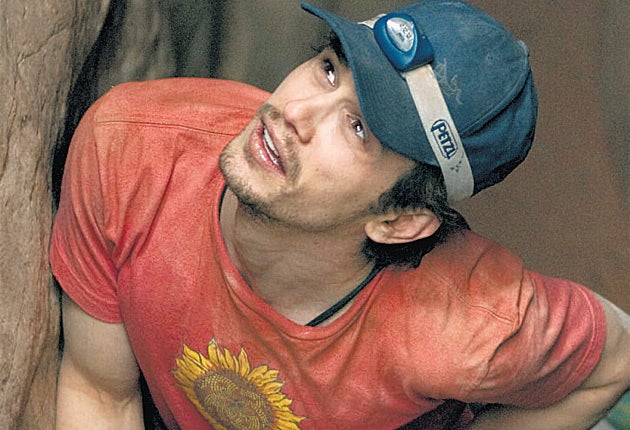Self-mutilation on film - What a carve-up!
In 127 Hours, a climber hacks his arm off with a knife. Strong stuff? Yes, but it's only the latest entry in cinema's rich history of self-mutilation, argues Kaleem Aftab

Characters hacking away at their own body parts are becoming an increasingly prevalent phenomenon on the silver screen. Much of the talk about Danny Boyle's 127 Hours, starring James Franco, has centred on the gruesome moments that show the protagonist Aron Ralston cutting off his own arm to free himself after he gets trapped under a boulder.
The rock has trapped the mountain climber in a ravine, and the decision to cut comes after five days of deliberation. The moment is made all the more excruciating by the fact that the blade he has to use to cut off his own arm is blunt.
It's hard to watch, but nonetheless it's still surprising that audience-members have fainted at screenings, given how common it is to see characters in situation where they are forced to chop off a limb. It's practically become a cliché of the horror genre.
In Saw, the first episode of the hugely successful franchise, two unsuspecting victims find themselves chained at their ankles. They discover that hacksaws have also been left in the room, and initially they try to free themselves from their shackles by sawing through the metal. When they discover that this is futile, they realise that the only way they can free themselves is by using the hacksaw to cut through their bones. Facing certain death, Cary Elwes's Dr Lawrence Gordon starts sawing off his own foot.
Often, a character will chop off his arm because it's been infected or possessed by some force or other. There is a hand-over-your-eyes moment in the alien invasion sci-fi thriller District 9, when the clueless bureaucrat Wikus starts to develop prawn-like claws in the style of the aliens that have been quarantined in South Africa. So he decides to chop his own arm off, rather than transform into an alien.
In Evil Dead 2, self-mutilation is played for laughs. Part of the comic gold is down to Bruce Campbell's superb performance. Fighting with himself after a demonic spirit possesses his hand – a battle that involves plates being smashed, hair being pulled and comic somersaults – Campbell finally picks up a chainsaw and takes it to his own arm while screaming, "Look who's laughing now", as blood pours over his face.
Literally beating yourself up is a central component of Fight Club. The David Fincher film revolves around a bare-knuckle fighting club in which characters take pleasure in being beaten to a pulp. The reveal is that Tyler Durden (Brad Pitt) and the nameless narrator (Edward Norton) are one and the same, meaning that the narrator has been smashing himself to pieces throughout the picture until he eventually shoots himself through the mouth. It's important in these self-harm moments that the characters don't kill themselves.
There are a plethora of films, from Girl, Interrupted to Thirteen, that involve characters (usually female) hating themselves to the extent that they will cut themselves. Black Swan is the latest to join the long list: in Darren Aronofsky's ballet film, Natalie Portman's dancer repeatedly looks into the mirror and tries to work out ways to hide her latest scars.
But cutting off arms and legs seems mild compared to the number of films that involve characters cutting off their own genitals. The most graphic case is surely Lars von Trier's Antichrist. Charlotte Gainsbourg plays an unhappy wife who uses a pair of scissors to cut off her own genitalia. When the film was released uncut in Britain, the BBFC insisted that the poster carry the warning, "Contains strong real sex, bloody violence and self-mutilation."

Watch Apple TV+ free for 7 days
New subscribers only. £8.99/mo. after free trial. Plan auto-renews until cancelled

Watch Apple TV+ free for 7 days
New subscribers only. £8.99/mo. after free trial. Plan auto-renews until cancelled
Von Trier was following in the footsteps of Ingmar Bergman's Cries and Whispers and Michael Haneke's The Piano Teacher. In Cries and Whispers, Karin is in a loveless marriage with a diplomat. After yet another mundane dinner party, Karin takes a broken wine glass and mutters, "It's all a pack of lies", before striking herself in the genitals in front of her husband. Smearing blood over her own face, she laughs in triumph. The piece of glass is shown sitting on a silver tray in her bedroom. Equally difficult are the scenes of self-mutilation in Haneke's The Piano Teacher, in which Isabelle Huppert delivers a tour-de-force performance.
Whether it's to save their own lives as a necessity caused by a drastic situation, an act prompted by self-hate or depression, or even done for laughs, it seems that the people most likely to harm the principal protagonists in movies these days are themselves.
Subscribe to Independent Premium to bookmark this article
Want to bookmark your favourite articles and stories to read or reference later? Start your Independent Premium subscription today.

Join our commenting forum
Join thought-provoking conversations, follow other Independent readers and see their replies